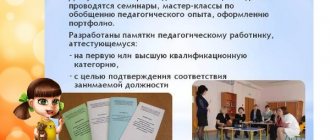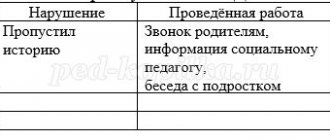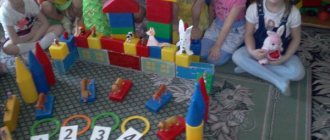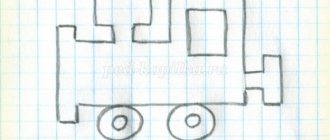Hello, dear friends! I have news: they finally paid attention to children and began opening groups for children with disabilities in kindergartens. Some educators who have not completed courses (on organizing inclusive education for children with disabilities) are discouraged by the fact that educators in such groups receive higher salaries and additional vacation days. Today I will try to clearly explain what it is like to work with this group of children and why teachers who have undergone special inclusive training are given some privileges.
Who is included in the HIA group?
By the way, if anyone wants to study the legal framework on this issue on their own, I can recommend the manual “Education of children with disabilities in accordance with the Federal State Educational Standard of the NOO. Local legal acts”, you can buy it on the portal “Labyrinth.ru”.
So, it is worth noting that a referral to a group for children with disabilities can be obtained after passing a special psychological, medical and pedagogical commission and only with the consent of the child’s parents or guardians. Considering the child’s rights to choose the form and method of receiving education, experts can only recommend that the mother transfer the baby to a special group.
The fact is that sometimes parents do not notice deviations in the child’s behavior, which indicate the presence of a certain disease that reduces his ability to receive education in the usual way. There are children who were born with obvious deviations in health and development, and there are cases when only by certain signs noticeable to a specialist can one determine the presence of some kind of defect.
You need to be very attentive to your children and, at the slightest suspicion, contact a specialist. After all, most minor developmental and health defects can be corrected and forgotten about, but only with early diagnosis.
Children can be trained in a correctional group if they have the following defects:
- Impaired hearing, vision, speech;
- Mild mental retardation;
- Negative mental states;
- Psychopathic-like forms of behavior;
- Pedagogical neglect;
- Mild motor pathology;
- Complex forms of allergies;
- Frequently recurring general diseases.
It is worth noting that the listed pathologies should be in a mild form, but if the pathology is severe, the child simply physically cannot be outside the home and without his parents.
How to work with children with disabilities in preschool educational institutions according to the Federal State Educational Standard: normative documents
Federal state educational standards for preschool education
Federal state educational standards for preschool education consist of a list of relevant tasks that require implementation. They were developed in accordance with the Constitution of the Russian Federation, legislation, taking into account the United Nations Convention on the Rights of Children. These tasks include:
- protect and strengthen the physical and mental health of the child, including his emotional well-being;
- provide equal opportunities for the development of any child in preschool, including children with disabilities. This requires favorable conditions where the child can develop according to his characteristics and while maintaining his own self-esteem;
- provide options and a variety of foundations and forms for preschool educational programs, with the possible formation of methods in various directions, taking into account the educational needs, abilities and health status of each child;
- provide families with support from psychologists and teachers, increase the knowledge and skills of close relatives on the issues of education, support, and treatment of the baby.
Federal state educational standards for preschool education have been developed taking into account the individual needs of all children, according to life situations, as well as their health. The Federal State Educational Standard determines the appropriate conditions for providing a child with education, special educational needs, and individual special requirements for certain categories of children and children with disabilities.
Features of working with children with health limitations
You need to understand that regardless of the state of the child’s physical and mental health, he has equal rights to receive an education, like other children. It’s just that an individual development program and a deeper focus on the child’s development are drawn up for children with disabilities.
To help myself and all my colleagues who work or plan to work in a correctional group, I selected thematic books in the same “Labyrinth”:
- “Inclusive education. A Handbook for a Teacher Working with Children with Disabilities" - this methodological guide with recommendations for overcoming developmental defects will be of interest to all interested parties;
- “Social and communicative development of children with disabilities in accordance with the Federal State Educational Standard” - a CD from the “Pedagogical Video Workshop” series contains materials on creating a developmental environment that will maximize the potential of each child.
Children with disabilities have the right and should be raised and developed in a group of their peers. For this purpose, special groups are created or such children are integrated into a regular group in the so-called mass kindergarten (as opposed to a specialized one). By the way, the stay of children with disabilities in kindergartens is free.
I really like the expression: creating a barrier-free development space. This is a succinct phrase, isn’t it, which characterizes the main task of a teacher who works with this group of children. We must do everything so that children with disabilities can receive full-fledged preschool education and education in a regular kindergarten.
The main feature of working with children with health limitations is the constant psychological, medical and pedagogical support of children by competent specialists who work closely with each other. Working with these kids involves a comprehensive search for ways to overcome defects and complete socialization in society.
Educators alone cannot solve the problem of correcting the physical or psychological problems of children. Only together we will overcome everything, including with the help of our parents. And this is not just my opinion, many experts with whom we took courses think so.
Outline of an individual lesson for children with disabilities on FEMP
Outline of an individual lesson for children with disabilities on the formation of elementary mathematical concepts.
Topic: "Geometric shapes."
Goal: To consolidate ideas about geometric shapes. Objectives: 1. Educational
: develop skills in recognizing geometric shapes, consolidate the correlation of primary colors, develop the ability to compare geometric shapes by color, develop the ability to find objects that have a common feature and find unnecessary ones.
2. Correctional:
develop cognitive skills, thinking, voluntary attention, concentration, visual memory, coherent speech, fine motor skills.
3. Educational:
to develop the ability to self-control, perseverance, hard work, create a positive emotional background.
Equipment: figures cut out of cardboard or colored paper (circles, squares, triangles, rhombuses, ovals, rectangles), strips of paper with figures drawn in a row (sample), strips of white paper, a box, a landscape sheet, glue, felt-tip pens or pencils. Lesson type: consolidation of the material covered.
Lesson progress
1. Organizational moment: Teacher: -Hello, dear friend! The lesson begins. Come to us without delay, try, help us work hard, (child’s name) came to us to study! 2. Updating previously acquired knowledge: Teacher: - Today you and I will play one very interesting game, and it’s called “Confusion.” Close eyes! (The child closes his eyes, at this time the teacher lays out geometric shapes in piles on the table) Open your eyes and see what I have prepared for you. Let's remember what these figures are called and name their colors, and then start playing. (The child names the shapes and their colors one by one) Well done, now let’s play! Now I will mix all the figures, and you will have to find and give me all the green triangles. (The child finds the green triangles and gives them to the teacher) Okay, now find all the blue circles. (The teacher names all the shapes and their colors one by one, the student finds the ones they need) Look at what shapes are left and name their colors (Purple and orange rectangles, black and white diamonds) Put the black diamonds on the orange rectangles, and hide the black diamonds under the purple rectangles. Well done, you did very well! 3. Game “Restore the row”. (training visual memory and voluntary attention): Teacher: - You completed the first task, now we can move on to the next game. Look carefully at this row of figures and try to remember everything. (The teacher shows the child a strip of paper with drawn figures for 20 seconds, the child looks and remembers) Now I will hide the picture, and you try to remember and name all the figures that were depicted on it. (The child names the figures) Well done, try to arrange the figures as they stood in the picture (The teacher gives the child a strip of paper and cut out figures) Okay, let's check if you got it right! (The teacher shows the child a sample, together with the student finds errors. The game is repeated several times. The number of figures gradually increases: from two to four or more) 4. Finger gymnastics: Teacher: - Before continuing to play, let's stretch our fingers! Look at me carefully and repeat the movements. Let's play with our fingers and name the shapes! Here is a square (Raise your index fingers up, put your thumbs at right angles, first connect the tips of your index fingers to each other, then connect the tips of your thumbs), but here is a circle (Connect the pads of your index and thumbs, round your fingers), well, no be lazy, my friend (Shak your index finger), show a triangle (Join your index fingers in a “house”, place the thumb of your right hand on the thumb of your left hand), fold your fingers into a rhombus (Love your thumbs down, connecting them “house”), and now a rectangle and show the oval to everyone (connect the tips of the thumbs and ring fingers to form a rectangle, connect the tips of the thumbs and index fingers, then shape them into a circle, lower them a little to obtain an oval). 5. “What did the artist forget? "(game for developing thinking and fine motor skills): Teacher: - We rested a little and prepared our fingers for work. Look, an artist I know gave me four pictures; he drew a pattern on them, but forgot which figure should be at the end. What figure do you think the artist forgot to draw? (The teacher shows the child paper strips with a drawn pattern of figures: the figures are arranged in a row, one or two are missing. The child must understand the pattern and name the missing figure). Well done, the artist really forgot to draw this figure, let's help him do it and finish the picture! (The teacher helps the child trace and color the figure. If the child can draw the figure independently, the teacher controls the correctness of the task and helps to do the work carefully. The game is repeated several times) 6. “Find the odd one out” (a game for the development of mental activity, coherent speech): Teacher : - You're a big lad! I have another interesting game for you. It's called "Find the odd one out." Now I will arrange the figures in a row, and you try to find the extra one and explain why it is the extra one. (The teacher lays out a row of three to four shapes on the desk, adding one extra. First, the shape is extra in shape (e.g., 3 circles and 1 square), and then in color (e.g., 3 yellow circles and 1 blue). Child must not only point out the extra figure, but also explain his choice in detail) 7. “Magic Box” (a game for developing recognition of geometric figures): Teacher: - Look what I have! This is a “magic box” and today you can play with it. Close eyes! (the child closes his eyes, the teacher places one geometric figure at the bottom of the “magic box”. The figure should be large enough) Now put your hand in the box and try to determine which figure is hidden in it. You can't get the figure out! (The game is repeated several times. Opening the eyes, the child names the color of the figure) 8. “Funny pictures” (fine motor skills training, development of visual perception, imagination) Teacher: - Let’s fantasize a little and try to make funny pictures from the figures, and then make them applique. (If a child has difficulty completing a task and cannot independently create a picture using geometric shapes, the teacher offers him a sample). 9. Final stage: - Let's remember what games we played today? Which game did you like the most? What was the most difficult task? Well done, you did a very good job today! I'm waiting for you at the next lesson. Goodbye!
We recommend watching:
Math holiday in kindergarten. Senior group: Notes of the GCD on FEMP in the preparatory group with a presentation of the Summary of GCD on FEMP in the preparatory group. Solving problems Summary of GCD for FEMP in the preparatory group. Traveling around the country "Mathematics"
Similar articles:
Notes for mathematics classes in the senior group
Summary of a lesson on FEMP in the senior group of a preschool educational institution. Topic: Orientation in space
Summary of a math lesson in the senior group on the topic: New Year
Summary of a lesson on FEMP in the senior group of a preschool educational institution. Topic: “Composition of a number of units (number 7)”
Planning for FEMP in the senior group according to Pomoraeva
Methodological help for teachers
Today, there are various forms of self-education, including literature, seminars, courses, etc. How to manage everything? You can take training online without leaving your home and receive relevant certificates that will not be superfluous in your portfolio.
I always find particularly advantageous offers for seminars at UchMag:
- “Development of fine motor skills in children with disabilities using non-traditional equipment”;
- “Federal State Educational Standards of the National Educational Institution: Correctional and Pedagogical Support for Children with Disabilities”;
- “Special education of children with special educational needs”;
- “Methods, techniques and forms of working with parents on the development and correctional pedagogical assistance to children with disabilities.”
What are the difficulties of working with children who are not entirely healthy?
The fact is that such children are characterized by some motor retardation or hyperactivity, insufficient coordination of movements, poor performance, low socialization, intellectual disability, deviations in cognitive processes, etc.
Usually the adaptation of such a child occurs with great difficulties, since there is low self-esteem and various fears. But at the same time, according to experts, one defect is compensated by an inflated positive quality in such children. For example, children who are hard of hearing have sharp eyesight and a great interest in fine arts. And visually impaired children have a well-developed so-called sixth sense.
To work with this contingent of pupils, it is not enough to just be a teacher with a standard preschool education. You need to take special courses, study a lot of literature on your own, study not only your responsibilities, but also delve into the psychology of these children, understand the peculiarities of their physical condition.
For each child with disabilities, a profile is written by each specialist who works with him. Periodic monitoring of the child’s development dynamics and health monitoring, both physical and psychological, are carried out.
In short, very difficult, but very important work is being done - correction of child health defects.
In simple terms, they simply work with children and teach them not to be shy, but to be successful in other activities among their peers. The teacher must pay attention to the abilities of the child and the students in the group.
Directions of correctional work with children
Children who attend a correctional group are treated according to the same principle as with ordinary children, but taking into account the characteristics of this contingent.
Thus, much attention is paid to the following areas:
- Development of physical health. A physical education or physical therapy instructor develops an individual program for each child, which provides for the correction of certain physical defects.
The teacher, together with the psychologist, uses physical education as a tool to strengthen willpower, an active life position, motivates children to make independent decisions and develops the ability to get out of difficult situations. This strengthens the baby's emotional health and makes him stronger in every way.
- Development of cognitive qualities. Using the principle from simple to complex, relying on the principle of clarity, other methods and techniques that are suitable for each specific child teach children the skills of independent exploration of the world. The difficulty is that each child has his own health and psychosomatic characteristics, so a careful selection of methodological tools is required.
- Social and communicative development. This is an extremely important direction specifically for children with disabilities. They need to be taught the most basic everyday things that will facilitate their socialization. Healthy children learn self-care and communication skills naturally, gradually.
Children with disabilities experience difficulties with the simplest actions and often have problems with speech. The speech therapist and teacher solve these problems on two fronts, working individually with each child. Both teachers and parents of children with disabilities participate in organizing a communicative and developmental environment. A separate area is educational work with mothers and fathers.
We are working together to teach everyday skills and communication skills.
- Artistic and aesthetic development. Through classes in music, drawing, modeling, etc. Children very effectively develop fine motor skills, master the skills of working with different materials, and learn to interact with the teacher and friends. Art is very important for such children; they are often extremely receptive to music and love everything beautiful.
Working with children with disabilities in preschool educational institutions
Work of a teacher with a child with disabilities
A teacher, when drawing up an individual lesson plan with a child, should be based on a conversation with him and his parents, a very detailed study of the child’s medical record, mental and physical examinations of the baby’s health. Further work of the teacher with a child with disabilities is carried out strictly according to an individual plan. The teacher must perform the following activities:
- conduct classes related to productive activities with each child separately or by uniting children in appropriate groups;
- develop finger motor skills;
- instill cultural and hygienic skills;
- organize individual lessons with children, taking into account the recommendations of speech therapists and psychologists;
- create a favorable atmosphere in the group;
- advise parents on the topic of creating knowledge on culture and hygiene, how it is necessary to develop children’s fine motor skills and their health characteristics.
Working as a nanny with a child with disabilities
A nanny in a preschool institution for children with health problems helps to dress and feed the baby, if necessary, communicate competently with him, and know how to provide first aid. Including, she should accompany the kids on walks, look after them during classes, and organize them proper rest.
Work of a teacher-psychologist with a child with disabilities
A teacher-psychologist in a preschool educational institution performs the following tasks:
- organizes interaction between teachers;
- works with children on psychoprophylactic and psychodiagnostic features;
- adjusts work with each child at risk;
- develops correctional programs for the individual development of the child;
- increases the level of psychological knowledge of teaching staff;
- advises the child's parents.
Work of a speech therapist with a child with disabilities
The speech therapist should:
- diagnose the level of expressive and impressive pronunciation of words and letters;
- develop individual training plans;
- conduct individual lessons;
- consult teaching staff, including parents.
Work of a physical education instructor with a child with disabilities
He conducts activities to improve the child’s health and improve the psychomotor skills of children.
Work of a music worker with a child with disabilities
Music worker:
- develops musical and aesthetic skills in children;
- selects material that allows conducting classes according to the physical, speech, and psychological abilities of children;
- uses music therapy tools.



